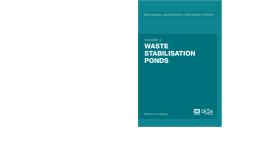
Additional Information
Book Details
Abstract
Waste Stabilisation Ponds is the third volume in the series Biological Wastewater Treatment. The major variants of pond systems are fully covered, namely: facultative ponds anaerobic ponds aerated lagoons maturation ponds The book presents in a clear and informative way the main concepts, working principles, expected removal efficiencies, design criteria, design examples, construction aspects, operational guidelines and sludge managment for pond systems.
About the series: The series is based on a highly acclaimed set of best selling textbooks. This international version is comprised by six textbooks giving a state-of-the-art presentation of the science and technology of biological wastewater treatment. Other titles in the series are: Volume 1: Waste Stabilisation Ponds Volume; 2: Basic Principles of Wastewater Treatment; Volume 4: Anaerobic Reactors; Volume 5: Activated Sludge and Aerobic Biofilm Reactors; Volume 6: Sludge Treatment and Disposal
Table of Contents
| Section Title | Page | Action | Price |
|---|---|---|---|
| Contents | vi | ||
| Preface | ix | ||
| The author | xiii | ||
| 1 Overview of stabilisation ponds | 1 | ||
| 2 Facultative ponds | 8 | ||
| 2.1 Introduction | 8 | ||
| 2.2 Description of the process | 9 | ||
| 2.3 Influence of algae | 11 | ||
| 2.4 Influence of environmental conditions | 14 | ||
| 2.5 Design criteria | 18 | ||
| 2.6 Estimation of the effluent bod concentration | 24 | ||
| 2.7 Pond arrangements | 38 | ||
| 2.8 Sludge accumulation | 39 | ||
| 2.9 Operational characteristics | 40 | ||
| 2.10 Polishing of pond effluents | 40 | ||
| 3 System of anaerobic ponds followed by facultative ponds | 46 | ||
| 3.1 Introduction | 46 | ||
| 3.2 Description of the process | 47 | ||
| 3.3 Design criteria for anaerobic ponds | 48 | ||
| 3.4 Estimation of the effluent bod concentration from the anaerobic pond | 51 | ||
| 3.5 Design of facultative ponds following anaerobic ponds | 53 | ||
| 3.6 Sludge accumulation in anaerobic ponds | 53 | ||
| 4 Facultative aerated lagoons | 58 | ||
| 4.1 Introduction | 58 | ||
| 4.2 Description of the process | 58 | ||
| 4.3 Design criteria | 59 | ||
| 4.4 Estimation of the effluent bod concentration | 60 | ||
| 4.5 Oxygen requirements | 63 | ||
| 4.6 Aeration system | 64 | ||
| 4.7 Power requirements | 64 | ||
| 4.8 Sludge accumulation | 66 | ||
| 5 Complete-mix aerated lagoons followed by sedimentation ponds | 70 | ||
| 5.1 Introduction | 70 | ||
| 5.2 Description of the process | 71 | ||
| 5.3 Design criteria for the complete-mix aerated lagoons | 72 | ||
| 5.4 Estimation of the effluent bod concentration from the aerated lagoon | 73 | ||
| 5.5 Oxygen requirements in the aerated lagoon | 75 | ||
| 5.6 Power requirements in the aerated lagoon | 76 | ||
| 5.7 Design of the sedimentation pond | 76 | ||
| 6 Removal of pathogenic organisms | 84 | ||
| 6.1 Introduction | 84 | ||
| 6.2 Process description | 84 | ||
| 6.3 Estimation of the effluent coliform concentration | 85 | ||
| 6.4 Quality requirements for the effluent | 96 | ||
| 6.5 Design criteria for coliform removal | 98 | ||
| 6.6 Removal of helminth eggs | 110 | ||
| 7 Nutrient removal in ponds | 116 | ||
| 7.1 Nitrogen removal | 116 | ||
| 7.2 Phosphorus removal | 121 | ||
| 8 Ponds for the post-treatment of the effluent from anaerobic reactors | 123 | ||
| 9 Ponds for the post-treatment of the effluent from anaerobic reactors Construction of stabilisation ponds | 127 | ||
| 9.1 Introduction | 127 | ||
| 9.2 Location of the ponds | 127 | ||
| 9.3 Deforestation, cleaning and excavation of the soil | 129 | ||
| 9.4 Slopes | 129 | ||
| 9.5 Bottom of the ponds | 132 | ||
| 9.6 Inlet devices | 133 | ||
| 9.7 Outlet devices | 136 | ||
| 10 Maintenance and operation of stabilisation ponds | 138 | ||
| 10.1 Introduction | 138 | ||
| 10.2 Operational staff | 139 | ||
| 10.3 Inspection, sampling and measurements | 139 | ||
| 10.4 Operation start-up | 139 | ||
| 10.5 Operational problems | 144 | ||
| 11 Management of the sludge from stabilisation ponds stabilisation ponds | 150 | ||
| 11.1 Preliminaries | 150 | ||
| 11.2 Characteristics and distribution of the sludge in stabilisation ponds | 151 | ||
| 11.3 Removal of sludge from stabilisation ponds | 152 | ||
| References | 159 |
